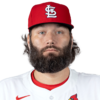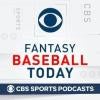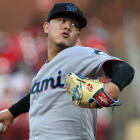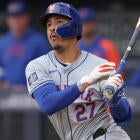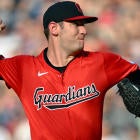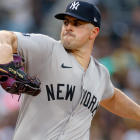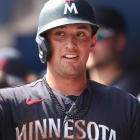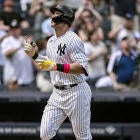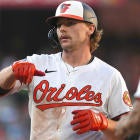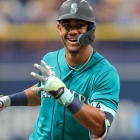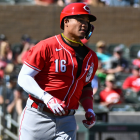Another column about pitchers? Another column about pitchers.
There's a reason I've tended to write about them more often than hitters this year: They're the one true differentiator in this post-BABIP, fly ball-maximizing, three-true-outcomes world that sabermetrics and juiced balls have brought about, wherein Ketel Marte can hit as many home runs as Javier Baez and Tommy La Stella can already have five more than in the five years prior.
Who needs another hitter, honestly? Sure, you can always find a league large enough to test the limits of the player pool, but in something closer to standard size, there are enough redundancies to go around. And while you may think there's always room to improve ... yes and no. This league-wide power explosion hasn't impacted everyone equally, mostly serving to bring the non-power hitters up to the level of the power hitters, to the point that what looks like a top-12 second baseman today could be top-five a couple weeks from now.
So maybe there's room to improve at one of your infield or outfield spots if you're accepting of incremental changes that may or may not stick, but if you're like me when you take the time to send out some trade offers, you mostly just want someone who can give you some consistency on the pitching side.
Everyone playing this game — everyone — has a need for more, even those who made the investment on Draft Day. Have you seen all the hand-wringing concerning Trevor Bauer, Patrick Corbin and Noah Syndergaard? Blake Snell is the latest join that group. And remember the concerns about Chris Sale early on? Walker Buehler? Max Scherzer, even? Justin Verlander is about the only big-dollar pitcher who hasn't at some point given us reason to wonder, and even his FIP is a full run higher than his ERA.
In an environment where not even those stalwarts can be trusted, who can you trust? It forces you to reexamine whatever you think makes for a good pitcher whenever someone within your reach strings together a few good starts. Sure, the tell-tale signs of a breakthrough aren't there, but maybe if you squint hard enough, stretch your reasoning to places it hasn't gone before, you can find an excuse to believe it, even if just to sustain you to the next flavor of the week.
You rationalize, in other words, and there's nothing wrong with it as long as you recognize you're doing it and are willing to hear out whatever offers may come your way or pull the plug when there's no longer a case to be made.
For these eight, we've all been complicit in overlooking their flaws, at least judging from their ownership rates. Each is at least 70 percent in CBS Sports leagues, and honestly, some of the more interesting ones are among the least owned.
And I'm not saying they shouldn't be owned. They're just not to be trusted, in whatever form that takes in your league. Try selling high? Maybe if you play in a league where nobody evaluates beyond ERA and Fantasy points scored. Dump for a stashable like Jesus Luzardo? Hey, if he's out there. Just ride it out because it's not like you can do any better? I'm sure we can all relate.
But don't get too comfortable. Sooner or later, with the exception of maybe one or two of these cases (read on for more), it'll backfire.
1. Zach Eflin, SP, Phillies
How topsy-turvy is this pitching landscape? Another participant in Tout Wars, a highly regarded experts league that's 15 teams deep, recently dropped Zach Eflin, which says something about the legitimacy of his numbers, and yet I, the guy writing a column telling you to be skeptical of him, spent one-fifth of my budget on him anyway, which says something about the state of desperation at starting pitcher.
I went in with my eyes wide open, which is easier to say the day after he turns in maybe his worst start of the season, but so few pitchers are even allowed to do what he has managed to do so far, pitching more than six innings in seven of his 15 starts for an average of 6.07. Maybe he's so precise with his cutter, missing barrels with it and all, that his line-drive and home run-to-fly ball rates will remain among the lowest in baseball. Or maybe he should have closer to a 4.50 ERA, as his SIERA and xFIP suggest, and Monday's start was just the beginning.
2. Lance Lynn, SP, Rangers
The season-long numbers don't quite do Lance Lynn justice, as any of his owners will tell you. He has a 3.34 ERA, 1.06 WHIP and 10.9 strikeouts per nine innings over his past nine starts, all of six innings or more, and the one miss during that stretch, a five-run outing on Saturday, was really just one bad inning followed by six brilliant ones. He has also struck out eight or more in half of his starts, including double digits a couple times, and you'll notice an inability to miss bats is a common trait among these eight.
So why is Lynn here? Well, he's been a perennial tease since having Tommy John surgery prior to his 2016 season. I've come to accept that his reputation makes it impossible for me to trade him for the kind of pitcher who could more reliably deliver the kind of numbers he has of late and am content to ride the wave while it lasts, but for it to last, Lynn will have to maintain a walk rate far lower than he's had before, as well as an anomalous home run-to-fly ball rate.
3. Julio Teheran, SP, Braves
Julio Teheran allowed seven earned runs to the Cubs on Monday, which must mean the regression already came, right? And a 3.94 ERA you'll still take from a pitcher who throws six-plus nearly half the time with a terrific offense backing him. A 3.94 ERA is exactly what he had last year, after all, and his K/9 and BB/9 are pretty much right in line with what he did then.
Yeah ... but no. He drastically outperformed his peripherals last year, and it's even worse this year, his xFIP and SIERA both pegging him for an ERA over 5.00. His walk rate is terrible for a soft-tosser, his strikeout rate is below-average, and like many of the pitchers on this list, he has benefited from good home run luck so far. I have sympathy for anyone who chooses to keep him on hand for whenever he's making two starts, but you have to understand you're playing with fire. And how's that turning out for you this week?
4. Rick Porcello, SP, Red Sox
I was a staunch defender of Rick Porcello last year, pointing out that middle-of-the-road ratios amount to big totals, namely in terms of wins and strikeouts, when attached to a reliable workload. And after a dreadful start this year, the workload has been as reliable as ever — he has thrown six-plus innings in 11 of his past 12 starts.
The problem is that the ratios aren't middle-of-the-road anymore. The strikeout rate is the worst it's been in five years. The walk rate is the worst it's ever been. The fly-ball rate is also worse, but he's been yet another beneficiary of an unusually low home run-to-fly ball rate so far. His 4.28 ERA last year was easier to defend when it came with an 3.87 xFIP, but his xFIP this year is 5.09. So while you may think he's been a little underwhelming, it could get worse before it gets better.
5. Zach Plesac, SP, Indians
A relatively unheralded call-up going seven innings in four of his first six starts while allowing two earned runs or fewer in five of them is like manna from heaven, given the current start of pitching, and has made Zach Plesac more or less a fixture for the Fantasy GMs who had the good sense to pick him up. And it is good sense to pick up something of value, even if that value is fleeting. Granted, the strikeouts haven't been there, which is a major red flag in an era when missing bats is the only sure method of home run prevention, but Plesac also had a 1.41 ERA and 0.79 WHIP in nine minor-league starts despite averaging less than a strikeout per inning.
Still, the only pitchers who get away with allowing as much contact as he does at the major-league level are extreme ground-ball types, and he's the furthest thing. I want to believe, but it can't last.
6. Mike Fiers, SP, Athletics
Mike Fiers threw a no-hitter on May 7 and hasn't been the same since. Like, really — he's made nine consecutive quality starts, good for a 2.51 ERA. The problem is that in only one of them has he struck out even six. He has had stretches like this one at multiple points in his career — stretches when his command is so spot on that he hardly gives up any hits — but normally during those stretches, his strikeouts are at their best. That they're not this time suggests the crash may be even harder for a pitcher with a 4.36 ERA since 2016, when all of this home run craziness began.
It's a wonder Fiers' ownership percentage isn't higher, honestly, given how consistent he has been as late, but perhaps the 5.08 FIP and 5.52 xFIP are enough to scare people away.
7. Jordan Yamamoto, SP, Marlins
Apart from Lynn, Jordan Yamamoto is the one pitcher on this list who I have real hope for thanks in large part to a solid minor-league track record highlighted by a 1.83 ERA, 0.83 WHIP and 11.1 K/9 last year. And so far in three big-league starts, he has obviously done much more right than wrong. But it's easy to have a 2.45 FIP when you haven't given up a home run yet — something the batted-ball data, particularly the high fly-ball rate, suggests won't last.
The bigger issue, though, is that he doesn't miss enough bats, his swinging-strike rate so far ranking down there with obvious pitch-to-contact guys like Dakota Hudson and Aaron Sanchez. Yamamoto is sort of an oddity in that he has relied on a different pitch in each of his three starts, and with an arsenal that's six pitches deep, perhaps he'll be able to table the four-seamer enough to keep hitters off balance. It would be a rare feat to pull off, though, and after three starts, I'm not ready to believe in unicorns.
8. Merrill Kelly, SP, Diamondbacks
Merrill Kelly has been markedly better of late, not only compiling a 2.36 ERA, 0.82 WHIP and 8.4 K/9 over his past five starts but doing so with a swinging strike rate that would actually rank in the upper third of qualifying pitchers. He has featured his curveball and cutter more during that time, which of course adds a layer of deception, and has said he's beginning to feel more comfortable with his surroundings after spending his past four years in South Korea.
But is that league more geared for offense than this one? He gave up a lot of hits, more than one per inning, in his four years there and had a 4.09 ERA just last year. So unless what he's doing here in June is a breakthrough above and beyond anything he's ever done before, which would be convenient timing for the 30-year-old, he's probably just another Mike Leake type who'll have stretches of relevance but struggle to keep his ERA on the right side of 4.50.




